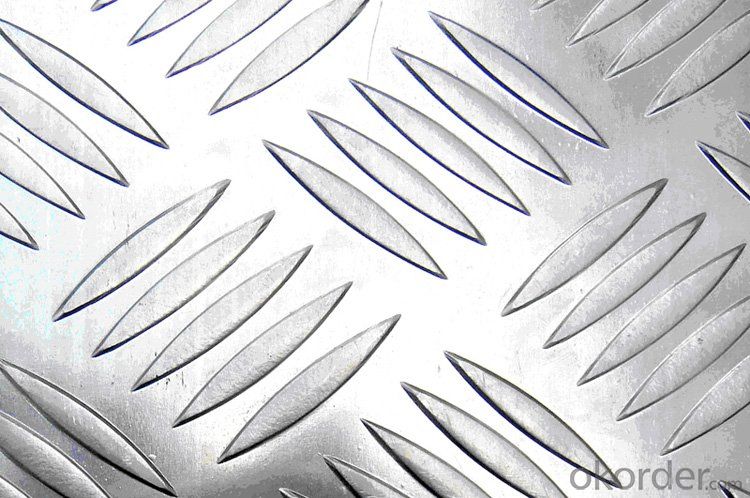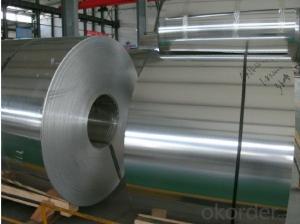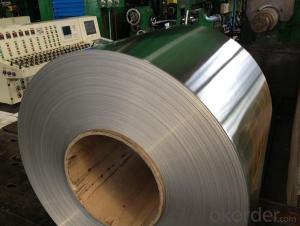Aluminum Sheets At Home Depot - Aluminium Coils with Mill Finished for Cold Rolling
- Loading Port:
- Shanghai
- Payment Terms:
- TT OR LC
- Min Order Qty:
- 5 m.t.
- Supply Capability:
- 5000 m.t./month
OKorder Service Pledge
OKorder Financial Service
You Might Also Like
Specification
1.Structure of Aluminium Coils with Mill Finished for Cold Rolling
Aluminium Coils with Mill Finished for Cold Rolling can be rolled down to aluminium coil,sheet,circle ect. The alloy AA1050 is widly used in building, industry ect. Its weight is much lower than steel. So many customers choosed aluminium material instead of steel.
2. Main features of Aluminium Coils with Mill Finished for Cold Rolling
a.Competitive price---We have our own mills and can produce mill finished aluminium coils, so we can control the production cost better.
b.Professional after-sale service---We have more than 15 years exportation experience and you need not worry about the exporation problems.
c.Fast delivery time---We can control the delivery time within 35 days.
3. Image



4. Product Specification of Aluminium Coils with Mill Finished for Cold Rolling
| Alloy | Temper | Thickness | Width | Weight |
| AA1050 | H14 | 0.2-3MM | 1000-1800MM | 2 tons |
5.FAQ of Aluminium Coils with Mill Finished for Cold Rolling
What is the quality standard?
---Usually our standard is GB3880-2006
What is the largest width?
---It is 2300mm
What is the MOQ?
---Usually we can accept 80 tons.
- Q: This is kind of odd, but if a volcano erupted and the lava dripped into an aluminum can, would the can melt? Would the lava harden and cool in it?
- Temperature of lava - 700 degrees Celsius. Melting point of aluminum - 660 degrees Celsius. I'll let you figure out if the can would melt...
- Q: i want to a material which is similar in properties like aluminium which has similar casting properties and easily available.
- It depends on what properties you are interested in. If you want specific answers, you need to ask specific questions. The previous answerers are not very well informed... There are, in fact, many excellent Al based casting alloys. And... cast alloys of brass, pot metal, lead, etc are not very similar to Al (but, again, it depends on specifically what properties you want). Consult your friendly neighborhood metallurgist but think about exactly what characteristics you need to have. The more completely you can define your requirements, the better someone can advise you on the pros and cons of different material selections.
- Q: Are aluminum sheets suitable for signage applications?
- Yes, aluminum sheets are suitable for signage applications. Aluminum is a lightweight and durable material, making it perfect for outdoor signs that need to withstand various weather conditions. It is resistant to rust and corrosion, which ensures the longevity of the sign. Aluminum sheets can be easily customized and cut into different shapes and sizes, allowing for versatile and creative signage options. Additionally, aluminum is a great material for digital printing and can provide high-quality graphics and images. Overall, aluminum sheets offer excellent durability, versatility, and aesthetic appeal, making them a popular choice for signage applications.
- Q: I had this mandarin orange can. I filled the can with water. Four days later, there are quarter inch thick rust cakes on the inside of the can. Since I assume the can is aluminum, are these cakes aluminum oxide? If so, is it flammable and/or dangerous?
- Aluminum oxide is white and powdery in texture. It also takes a bit longer for aluminum to oxidize than iron, so I don't think you could have cakes of aluminum oxide in 4 days. If the cakes you are describing are reddish in color, then no, it is NOT aluminum oxide. It is good old fashioned ferric oxide- rust from iron.
- Q: Can the aluminum sheets be used for manufacturing electrical conductors?
- Yes, aluminum sheets can be used for manufacturing electrical conductors. Aluminum is a highly conductive material and is frequently used in the electrical industry for making wires and cables.
- Q: How do aluminum sheets perform in high-temperature environments?
- Aluminum sheets generally perform well in high-temperature environments due to their excellent thermal conductivity and high melting point. They can withstand elevated temperatures without significant deformation or loss of structural integrity. However, at extremely high temperatures, aluminum may experience some oxidation or corrosion, which can affect its performance.
- Q: Are 101 aluminum sheets suitable for automotive body panels?
- Certainly, automotive body panels can be made suitable by utilizing 101 aluminum sheets. This particular alloy, known as 101 aluminum, possesses remarkable attributes such as high strength, good formability, and corrosion resistance, rendering it an exceptional option for automotive purposes. Moreover, its lightweight composition aids in enhancing fuel efficiency and the overall performance of vehicles. Furthermore, 101 aluminum's impressive dent resistance ensures that body panels can endure impacts while preserving their structural integrity. All in all, opting for 101 aluminum sheets to create automotive body panels proves to be a pragmatic and efficient decision.
- Q: Can aluminum sheet be used for architectural façade systems?
- Indeed, architectural façade systems can make use of aluminum sheet. The lightweight, durable, and corrosion-resistant properties of aluminum make it a favored option for building exteriors. It can be easily manipulated and fabricated into a plethora of shapes and sizes, thus rendering it suitable for the creation of intricate designs and architectural elements. Moreover, aluminum can be coated or treated in various ways to enhance its appearance and shield it from weathering. The versatility, aesthetic appeal, and long-term cost-effectiveness of aluminum sheet make it an exceptional selection for architectural façade systems.
- Q: What is the typical fracture toughness of aluminum sheets?
- The fracture toughness of aluminum sheets can vary depending on several factors, such as the composition of the alloy, the heat treatment, and the manufacturing process. On average, the fracture toughness of aluminum sheets ranges from 20 to 40 MPa√m. This value reflects how well the material can resist crack propagation and withstand applied loads without breaking. It's important to note that the fracture toughness of aluminum alloys can be improved through techniques like adding alloying elements and refining the grain structure. Therefore, when considering the fracture toughness of aluminum sheets for a specific application, it's crucial to take into account the specific alloy and its processing conditions.
- Q: Hello,Does it matter what kind of wheel I use as a cut off wheel on an angle grinder when cutting aluminum?Thanks!
- Yes but its for general purpose straight cuts. I've been using a Metabo cutting wheel in lieu of a torch for cutting,including stainless that's 3/16 or less. They work great, are inexpensive, and fit angle grinders.
Send your message to us
Aluminum Sheets At Home Depot - Aluminium Coils with Mill Finished for Cold Rolling
- Loading Port:
- Shanghai
- Payment Terms:
- TT OR LC
- Min Order Qty:
- 5 m.t.
- Supply Capability:
- 5000 m.t./month
OKorder Service Pledge
OKorder Financial Service
Similar products
Hot products
Hot Searches
Related keywords




























